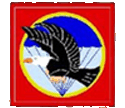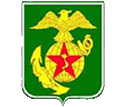

The Army of the Republic of Vietnam (ARVN) was the land-based military forces of the Republic of Vietnam (South Vietnam), which existed from October 26, 1955 until the fall of Saigon on April 30, 1975. The ARVN is often erroneously used as a collective term to refer to all South Vietnamese ground forces but, there were several types of South Vietnamese military forces involved in the war. Besides various army units there was also the Vietnamese Air Force, the Republic of Vietnam Navy, the Popular Forces (PFs), and the Civilian Irregular Defense Group (CIDG), also referred to as Regional Forces (RF's). ARVN Divisions were initially formed around the early to mid-1950's by the French and were initially assigned to areas in North Vietnam. The original units were redesignated in the late 50's when they began moving south to the area known as I Corps during the Vietnam War.
The Army of the Republic of Vietnam (ARVN) had been financed by United States of America throughout the late 1950’s, 1960’s and, as a result of Vietnamization, to an even greater degree from 1970 to 1975. The South Vietnamese Army first took shape after the 1954 Geneva Agreement when the American Military Assistance Advisory Group (MAAG) set about creating a modern military force that was capable of defending South Vietnam against an invasion by troops from North Vietnam. By 1968, the ARVN was a potent force of approximately 250,000 men, armed with modern tanks and artillery. It could also call on South Vietnamese and US aerial and naval support. Supporting the ARVN were militia units, mainly the South Vietnamese Popular Force (PF's)and the Regional Forces (RF's), consisting of about 250,000 men, and made up of small rifle units equipped with modern radios, vehicles and small arms. The organization of the ARVN and the militia was very similar to the organization of the American military. In 1964, the militia was made a formal part of the ARVN and they were apportioned out to administrating provincial chiefs throughout South Vietnam to protected their home villages from attacks by first National Front for the Liberation of South Vietnam (NLF, or Viet Cong) forces and later by People's Army of Vietnam units to protect their home villages from attacks by first, the Viet Cong) forces and, later, from People's Army of Vietnam (PAVN/NVA). The biggest problem with the ARVN forces was they were trained to use conventional tactics, whereas the forces of the North and their supporters in the South relied on guerrilla warfare. With the terrain of South Vietnam conducive to guerrilla tactics, this proved to be a decided weakness for the southern forces.
The local populace either supported members of the Viet Minh/Viet Cong, who were expected to help the peasants in their day-to-day life, or members of the ARVN; who frequently did little to endear themselves to peasant communities. The ARVN participated in ‘zippo’ raids whereby entire villages were burnt to the ground and the relocation of whole communities, having existed in the same village for several centuries, to protected villages supposedly safe from the threat from the north. In many cases, villagers resisted the relocation efforts and the ARVN had to resort to using force. Dubbed ‘Operation Strategic Hamlet’(an American idea), this effort failed to win the hearts and minds of the rural community in South Vietnam was a major reason why the ARVN failed in the long run. It was one of the reasons, put forward during Vietnamization, why men in the ARVN should be based as near to their homes as was feasible so that they might show a pride and determination in defending their own homeland against an expected all-out attack by NLF (Viet Cong) forces. These attacks did eventually occur; the two largest being the 1968 Tet Offensive and the Easter 1972 insurgency.
From 1965-1969, the ARVN took over most security operations as the Americans and other allies fought the main force war against the PAVN (NVA) and NLF (Viet Cong). As U.S. forces began to withdrawal in 1969, the ARVN took on a larger portion in fighting the communists and the Regional Forces and Popular Forces took on new importance. For the first time, they were deployed outside their home areas and were sometimes attached to ARVN units.
The I Corps Tactical Zone was defended by several different units of the Army of the Republic of Vietnam (ARVN) and was one of four "Corps" in which the ARVN were deployed . I Corps was the northernmost tactical region of South Vietnam, bordering with North Vietnam and encompassed five provinces: Quang Tri Province,(Khe Sanh, Dong Ha, Quang Tri City), Thua Thien-Hue Province,(Phu Bai, Hue City), Quang Nam Province,(Danang, Hoi An), Quang Tin Province,(Tam Ky, Chu Lai) and Quang Ngai Province,(Quang Ngai).
In the Easter insurgency of 1972, the NVA crossed the DMZ defeating the ARVN forces based there. They also attacked across the borders from Laos and Cambodia joining forces with the Viet Cong. The ARVN, equipped with modern American military weapons, inflicted heavy casualties on the North. Seemingly, the North had conquered much land in South Vietnam: but, it was sparsely populated land and they had only captured 2 major towns: Loc Ninh and Dong Ha. As a result of these losses, the North and South agreed to a ceasefire on January 23rd 1973, which took effect on January 28th. Few believed that the ceasefire would last and it was broken by the North towards the end of 1973. At that time, the ARVN numbered about 550,000 men and the NVA/Viet Cong was estimated to be between 500,000 and 600,000 soldiers. By 1973, the Popular forces consisted of 8,186 platoons, who primarily provided local defense and were too lightly armed and equipped to withstand attacks by (NVA) units supported by tanks and artillery.
As the NVA continued to move south toward Saigon, the ARVN defenders started to disintegrate and by 1975, the ARVN forces were in tatters and the North was soundly defeating the South. When the soldiers and tanks of the North drove into Saigon, they found piles of ARVN uniforms and weapons littering the streets: thousands of ARVN soldiers had deserted to merge with the citizens of Saigon for fear of reprisal. After the fall of Saigon and the communist victory, the Army of the Republic of Vietnam (ARVN) was dissolved. While some members had fled the country to the United States or elsewhere, hundreds of thousands of former ARVN soldiers were sent to re-education camps by the newly unified Vietnamese communist overnment. All tolled the combined military forces of South Vietnam are estimated to have suffered 1,394,000 casualties (killed and wounded) during the Vietnam War.
The 1st Infantry Division

The French formed the 21st Mobile Group was organized in September, 1953 and renamed the 21st Infantry Division later that year. It was formally disbanded in December, 1954 and restablished as the 1st Infantry Division. The 21st Mobile Group, one of the four original Republic of Vietnam Armed Forces (RVNAF) divisions, was formed from battalions native to Thua Thien and Quang Tri provinces, and the division (evolving finally as the 1st Infantry Division remained in that area. Headquartered at Hue from the time of its founding until January 1972, the 1st Division had its home six kilometers south of the city at a former US camp known to Americans troops as Camp Eagle. The 1st Infantry Division was considered "one of the best South Vietnamese combat units" in the warand it differed from most divisions because had 4 regiments as opposed to the normal 3 regiments.
Effective November 1, 1955 when the division became the 1st Field Division. 1st January 1959, the present title of 1st Infantry Division was adopted. The 1st Division was the only one of the four original Republic of Vietnam Armed Forces (RVNAF) divisions which were formed from units raised in the vicinity of division’s ongoing area of operation.
The 21st Mobile Group was formed from battalions native to Thua Thien and Quang Tri provinces, and the 1st Division remained in that area. Headquartered at Hue from the time of its founding until January 1972, the 1st Division had its home six kilometers south of the city at a former US camp known to Americans troops as Camp Eagle. In 1969 but in February that year another was set up and at Ai Tu, across the Thach Han River from Quang Tri city. Originally, the 1st, 2nd and 3rd Infantry Regiments. This division included an elite company, the Hac Bao, the Black Panther assault company that stopped an entire North Vietnamese battalion on the Hue airfield during the Tet offensive and later emerged victorious from a 72-hour battle against overwhelming NVA forces with 19 of its 240 men alive.
The 2nd Infantry Division

The 2nd Infantry Division, consisting of the 4th, 5th, and 6th Infantry Regiments, is a direct descendant of the 32nd Mobile Group. The 32nd Mobile Group became the new 32nd Infantry Division and was renamed the 32nd Field Division and then the 2nd Field Division. It was finally redesignated as the the 2nd Infantry Division in 1959. Three battalions, supporting artillery, and its headquarters unit were transported from Hai Phong to Nha Trang and then to Da Nang. The divisions headquarters alternated between Da Nang and Quang Ngaifor several years and it last moved from Da Nang to Quang Ngai in 1965 and remained there until 1972, after which it was finally moved to Chu Lai in southern Quang Tin Province.
The 3rd Infantry Division

The 3rd Division, was the newest of the ARVN infantry divisions, it was formed to guard the Demilitarized Zone (DMZ) following the withdraw of American troops from the area. Originally headquartered at a former forward headquarters of the 1st Division at the Ai Tu Base camp across the Thach Han River from Quang Tri City. The division scarcely reached full operational status when was driven from its position along the DMZ and, ultimately from Quang Tri Province in late March, April, and May 1972 by Communist forces supported by armor and heavy artillery. It was withdrawn to Da Nang to the former U.S. base known to American troops as Freedom Hill for reorganization and refitting. Sarting in mid-1972 it operated in Quang Nam and Quang Tin Provinces, with the security of the Que Son valley and Da Nang being among its primary responsibilities. The infantry regiments of the 3rd Division combine the oldest and newest in the South Vietnamese army. The 2nd Regiment, transferred to 3rd Division from the 1st Division on October 1, 1972, it was originally formed as the 22nd Regiment, 1st Division on November 1, 1954. and is one of the oldest Regiments in ARVN. The 56th Regiment was activated on December 1, 1971 and was formed from one battalion drawn from the 2nd Regiment, one battalion from the 51st Regiment (then independent), and one entirely new battalion. The 57th Regiment was activated on February 1, 1972 and was formed from one battalion drawn from the 2nd Regiment, one battalion from the 6th Regiment (2nd Division) and another entirely new battalion. Some of the troops brought into the 3rd Division that time were taken from Regional and Popular Forces units in Military Region 1.
The Airborne Division

The history of the Airborne Division goes back to August 1, 1951 when the 1st Airborne Battalion was formed by the French from Vietnamese elements of T.A.P.I. (Troupes Aéroportecs en Indochine). Five airborne battalions (1st, 3rd, 5th, 6th, and 7th) were formed during the French era. The best-known was the 5th Battalion which was almost completely wiped out in 1954 when it parachuted into Dien Bien Phu and suffered the same fate as the rest of the French garrison. On May 1, 1954, the French formed G.A.P.3 (Groupement Aéroport 3) which was reformed under the command of a Vietnamese officer on May 1, 1955. The 3rd, 5th, and 7th battalions in the North moved to the South in 1954 and, in 1955, the 7th Battalion was disbanded. The Airborne Group with headquarters, support units, and a training center, officially came into being on May 1, 1955 at Ton Son Nhut Airport at Saigon. At the end of 1959, the Airborne Group was redesignated the Airborne Brigade and in 1965, became the Airborne Division: divided into three Task Forces (1st, 2nd, and 35th) with an artillery battalion activated (two more were added later). In 1972, the Airborne Division was subdivided into three brigades the 1st, 2nd, and 3rd (created in May, 1968). The 1st, 5th, and 9th Battalions were assigned to the 1st Brigade; the 5th, 7th, and 11th Battalions, to the 2nd Brigade; and the 2nd, 3rd, and 6th Battalions to the 3rd Brigade. In the field, battalions were frequently placed under the operational control of brigades other than their parent brigade.
The initial formation of the airborne brigades were in Saigon and Hanoi: in Saigon, the 1st Battalion (1951), the 2nd Battalion (1965), the 6th Battalion (1954), the 7th Battalion (1961), the 8th Battalion (1959), the 9th Battalion (1965), and the 11th Battalion (1967). At Hanoi 3rd Battalion (1952) and the 5th Battalion (1953) were formed. The Airborne Division relied entirely on volunteers to fill its ranks. The 1st Division was located in I Corps in 1963 and 1964-66, II Corps 1963-64, 1966, IV Corps and III Corps 1968-71, I Corps 1972. From the onset of the Vietnam War, the Airborne Division was an elite unit with a proud combat record, the division at one time or another fought in virtually every part of South Vietnam as well as in Cambodia (1970-71) and Laos (1971). In February, 1971, Operation LAM SON 719, was initiated in Laos. The ARVN Airborne Division, with the 1st Armored Brigade attached, the ARVN 1st Infantry Division, and the ARVN Rangers were involved in the operation. The ARVN forces ran into a superior North Vietnamese force fighting on a battlefield that the enemy had carefully prepared. Conflicting orders from I Corps headquarters and the Airborne Division delayed reinforcement of a critical landing zone and the position was lost. The drive into Laos stalled and the Airborne Division buckled under the initial North Vietnamese attacks. The Airborne Division and its headquarters was deployed to the northern part of Military Region 1 in mid-1972. Finally, in a battle lasting from August to December 1974, the NVA 304th Division overran the key outpost of Thuong Duc in the mountains west of Da Nang and defeated a series of determined counterattacks mounted by two divisions, the 3d ARVN and the elite Airborne Division. This victory convinced NVA leadership that their soldiers could now defeat even the best ARVN troops and the surge to complete the take over of South Vietnam was on.
The Marine Division

The Marine division was descended from French organized commando companies and river patrol units. Two battalions of troops (1st and 2nd Bataillons de Marche) which the French had formed from commando companies in the North and South, respectively, were transferred to the control of the Armed Forces of the then State of Vietnam on January 1, 1954. The original elements were commando companies 1, 2, 3, 7, 13, 17, 24, 63, Commando Vendeberg, and Commando Nam Dinh. Following the July, 1954 Geneva agreement, the 1st Battalion moved to the South.
On October 1, 1954, the Viet Nam Marine Corps (VNMC) was formally created as part of Vietnam’s Navy and included one landing battalion, six riverboat companies, five combat support light infantry companies, one raiding party, headquarters and training units. The landing battalion was under the command of a French officer until 1955 and consisted of slightly over 1,100 officers and men. It was reorganized in early 1956 and the combat elements of the corps became the Marine Group (previously the Marine infantry). It became part of the general reserve of South Vietnamese armed forces in 1961. And in 1962 was redesignated the Marine Brigade.On July 1, 1964, two task forces, “A” and “B”, were established within the then Marine Brigade. July, 1968, Task Force “A” became Brigade “A” and Task Force “B” became to Brigade “B”. October, 1968, the Marine Division officially came into being and was composed of maneuver battalions, the three artillery battalions, and various support elements. All of the battalions were already formed at the time; the 1st (1954), the 2nd (1956), the 3rd (1959), the 4th (1961), the 5th (1964), the 6th (1966); the 7th, 8th and 9th were formed in 1970. In July, 1970, Brigade “A” became the 147th Brigade (1st, 2nd, and 3rd Battalions), and Brigade “B” became the 258th Brigade (4th, 5th, and 6th Battalions) and a new brigade, the 369th was formed (7th, 8th, and 9th Battalions).
The VNMC, which was composed entirely of volunteers, saw action in all parts of the Republic of Vietnam and also in Cambodia (1970-71) and Laos (1971). In the field, Marine battalions were frequently placed under the operational control of brigades other than their parent Brigade. As of 1972, the VNMC was officially assigned to the South Vietnamese Navy. however, the Navy, having no NVMC related responsibilities, necessitated the VNMC to be under operational control of the Joint General Staff. The Marine Division remained part of the RVNAF general reserve along with the Airborne Division and as deployed in Quang Tri province in 1972. It had operated in northern MR 1 since the Communist Spring Offensive of 1972 and maintained a forward headquarters in Quang Tri. Marine units recaptured Quang Tri City on September 16, 1972 after its abandonment by ARVN troops in May 1972.
| Return to History Page | Return to Home Page |